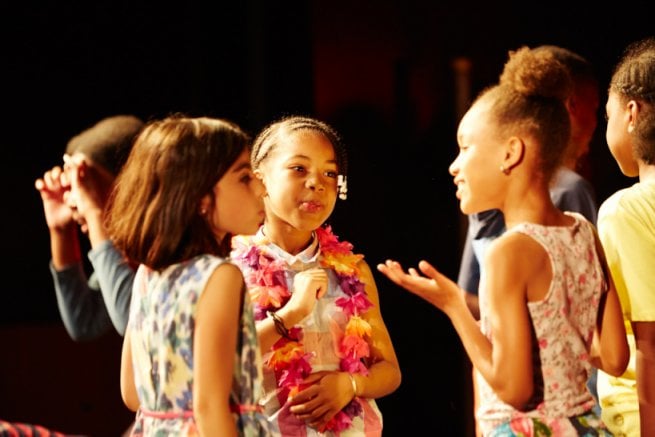
Young people working with dance company ZooNation at Haringey Shed
Photo: Simon Way
The right to a creative childhood
As creative subjects are squeezed out of the curriculum, what can arts organisations do to ensure all children benefit from culture? Maggie Atkinson has some suggestions.
There has never been a more important time to restate the value of arts and culture to the lives of all children and young people and to champion the centrality of schools in providing a universal, high-quality cultural education. It is especially important now as the education system has undergone significant changes in the past five years, including the introduction of a new national curriculum (which is markedly less prescriptive than its predecessor), and changes to school structures and governance with the rise of academies and free schools, as well as new accountability measures and exam structures (to name but a few shifts). It is inevitable in a time of change that some schools thrive and are able to use the shifting context to their advantage and some struggle and retrench their positions.
We have to concentrate on what can be done within this ‘new normal’ to ensure that all children and young people can have access to a fantastic cultural education
The arts sector has been very vocal about the impact of the EBacc on pushing secondary schools away from arts subjects. However, perhaps the very speed and complexity of change within education has meant there has been less understanding of how these policies in the round have made a difference to the way that schools work. There has also been relatively little public discussion of the way that arts organisations and other providers of culture or creative learning might need to shift and change in order to play a role in this new landscape.
The rights of the child have been the driving force behind my whole career and we will not achieve Article 31 of the UN Convention on the rights of the child – for all children to be able to participate freely in cultural life and the arts – without providing ‘first access’ at the very least within the school system. If we let the nurturing of arts and creativity for children become purely the preserve of families and the informal sector, we know that children from less well-off families will not have the same kind of opportunities as their peers, and that those who most need access to the cultural and social capital that engagement in culture brings will not benefit.
The education system we have now is here to stay, so the EBacc is here to stay. In London there is a population boom and hundreds of schools will have to open (and existing schools will need to expand) over the next few years in order to cope. This is the reality. Therefore we have to concentrate on what can be done within this ‘new normal’ to ensure that all children and young people can have access to a fantastic cultural education, rather than always looking for a new policy environment on the horizon. In a time when it is hard for schools to prioritise arts and culture, the cultural sector needs to step in to make it easier. As the chair of A New Direction, a London charity with a remit to tackle inequality of access to culture for children and young people, I am determined to galvanise the city’s extraordinary cultural assets for the benefit of our children. London could and should be the best place in the world to have a creative childhood, but for far too many this is not the reality of their experience of being educated in this city.
So what can cultural organisations do? First, ask yourself which schools you work with and why you work with them. Is it because they are the nearest? This is not a problem in itself, but a consequence of the cultural sector being primarily located in the centre of London means inevitably that inner London schools have more opportunities. Ask if you could collaborate with other cultural organisations to provide a joined-up offer to a group of schools rather than always having one-to-one relationships. This would make it easier for schools and potentially provide economies of scale. And finally, has your organisation got the resources in terms of staff capacity to think and operate strategically in regard to the education system?
We want cultural organisations to work with us to form local cultural education partnerships, supporting schools to achieve Artsmark and deliver the Arts Award, and offering opportunities for teachers. Some areas are already pioneering in this thinking. In Camden a group of cultural organisations, headteachers and local authority representatives are working together to support all schools in the borough to be able to commission needs-led partnerships with creative organisations. The East London Cultural Education Partnership sees a group of creative organisations collaborating to look at how they can collectively have the greatest impact for children and young people across the east of the city.
It will be very much in the interest of arts organisations to support schools in this way, not only to halt the decline in quality cultural education but also in terms of building the next generation of creative talent and developing new business models where schools are in a position to pay for far more creative content than is currently the case.
Maggie Atkinson is the Chair of A New Direction.
www.anewdirection.org.uk
Join the Discussion
You must be logged in to post a comment.